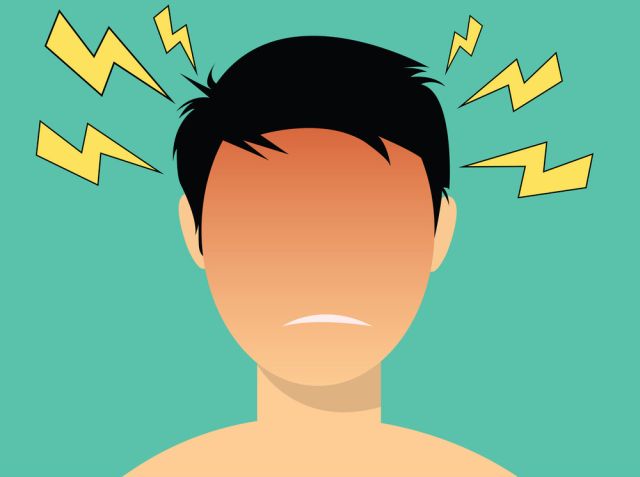Neck pain can be caused by several factors. This type of pain is usually related to stress and high blood pressure (hypertension). In these cases, the patient has no other symptoms. But there are other possible causes, such as meningitis, headaches, aneurysms or tumors.
It is not always serious, as it can also be the result of poor posture or the way a person goes to sleep.
Prolonged strain on the muscles in the region (caused by looking in one direction for a long time), excessive physical exercise and even the use of heavy collars can contribute to this pain.
In addition, a number of other conditions may be involved. Such as infections caused by viruses and bacteria or some diseases like rheumatoid arthritis and herniated discs.
In these cases, specific treatment for the disease or infection is essential to alleviate the problem.
In this article you will find:
- Severe pain in the back of the neck: what can it be?
- Is there a difference between right and left neck pain?
- Neck pain and other symptoms
- Are back pain severe?
- How to relieve neck pain?
Severe pain in the back of the neck: what can it be?

If the pain lasts for more than 1 week or spreads to other parts of the body such as the back or head, it is advisable to seek medical advice.
The patient must notice the intensity and periods of the day in which he feels the most pain. This will help the doctor make a more accurate diagnosis.
In general, if you are experiencing any discomfort in the region, you should urgently seek a doctor under the following conditions:
- If pain persists for more than 48 hours;
- If pain in the back of the neck is accompanied by fever, heart palpitation and other symptoms (vomiting, dizziness, for example)
That’s because it can be related to other complications. Even when it is due to poor posture, this sensitivity or local muscle irritation can cause great discomfort and limitation.
High pressure
In some cases, hypertension (high blood pressure) can be caused by pain in the back of the neck.
Although many people think that pain is due to increased pressure, it is exactly the opposite – it is responsible for arterial decompensation.
When the body experiences pain or stress, the body tends to release hormones (such as adrenaline) to fight them, and these hormones can help increase the pressure.
The pain in the back of the neck is temporary, that is, it should not last longer than 24 hours. Even so, if this situation is frequent, medical help should be sought.
Attitudes such as resting and avoiding the consumption of foods that contain too much salt or fat can help prevent increased pressure when pain is present.
Aneurysm
Aneurysms happen when there is dilation of blood vessels in the brain. This dilation can cause a cardiovascular accident (stroke or stroke).
In most situations, a stroke happens without any signs or symptoms.
But, in some cases, a stroke is preceded by severe pain in the back of the neck that can spread to other parts, such as the back, chest and head.
People who have had a stroke are more likely to have pain in the region, including the head, and they may have some compromised body movements.
Torticollis
Torticollis or “sprained neck” are pain caused by the misuse of the neck muscles. Poor posture, overweight or exertion, and sleeping in uncomfortable positions are the main causes.
Torticollis pain may appear during a movement (turning the neck to one side, for example) or physical exercise that uses those muscles (such as swimming).
Making hot/cold compresses on the injured area and taking pain relievers may be one of the medical recommendations.
Even so, only the medical analysis can predict which are the best medications and if there is a need for other recommendations (such as rest or interruption of some physical activity).
Meningitis

Meningitis is a disease caused by inflammation of the membrane of the brain and spinal cord. In most cases, this pathology is caused by bacteria or viruses.
During meningitis, the back of the neck may become painful or stiff, making it difficult for the neck to move naturally.
In addition, meningitis manifests itself accompanied by other symptoms such as headache, fever, vomiting and loss of appetite.
Meningitis can be prevented with vaccines and medications. In case of suspicion, seek medical attention.
Tumors
Despite being a less common cause, some tumors can cause pain in the back of the neck, especially if they are close to that location.
Thus, the pain is accompanied by other signs such as difficulty moving the neck, discomfort when swallowing and the presence of lumps.
These signs are indicative only and should not replace a doctor’s diagnosis. In case of suspicion, consult a medical professional who will be able to carry out tests and, if necessary, prescribe the appropriate treatment.
Is there a difference between right and left neck pain?
Unlike other parts of the human body, back pain does not differ between the left and right sides.
If it’s only on one side, it could be caused by stiff necks, overexertion, or poor posture.
Generally speaking, when it’s related to illnesses, both sides can hurt.
In both situations, this discomfort must be analyzed by a doctor who can correctly diagnose this complication.
Neck pain and other symptoms
When accompanied by other symptoms, pain in the back of the neck may be an indication to seek medical help. Between them:
Swelling
Swelling in the back of the neck is common to happen after a stiff neck or sprain. This nuisance tends to disappear within a few days.
If the pain and swelling remain for more than 72 hours (ie 3 days) without any sign of improvement, it is recommended to seek a doctor who can assess the situation and prescribe the best treatment.
Swelling in this area may make it difficult for your neck to move (such as lifting, lowering, or turning to one side).
Dizziness
Nape pain together with dizziness may indicate some illnesses like undefined or hypertension.
Crises of stress and anxiety can also favor the appearance of pain in the back of the neck, accompanied by dizziness.
The excessive use of technological devices (cell phones, for example) can result in dizziness and pain in the region, since, in most cases, posture and vision end up being compromised.
This pain can be eased with local compresses. The discomfort resulting from dizziness, on the other hand, can be fought by sitting or lying down and resting for a while.
Avoiding sudden movements when lying down and getting up can also alleviate these symptoms.
Nausea

Nape pain and nausea are symptoms that, when combined, can indicate several diseases such as:
- Meningitis;
- Labyrinthitis;
- Dengue;
- High pressure.
But only a medical diagnosis will be able to correctly define which disease causes the backache and nausea.
Headache
Pain in the back of the neck accompanied by headaches may be indicative of pathologies such as strokes and migraines.
Emotional pathologies such as depression and anxiety can result in these manifestations.
In some cases, the pain in the head may spread to the back of the neck and vice versa. If the pain is intense and lasting, seek medical help.
Are back pain severe?
In general, pain in the back of the neck is not dangerous, as long as it is a mild or punctual pain. It can often be caused by poor posture or poor sleep. However, if it is persistent, there are other symptoms, or if it worsens, professional help should be sought.
How to relieve neck pain?
How to relieve and treat back pain will depend on the cause. If it is a torticollis, for example, it is necessary to use medications that help in muscle relaxation and even compresses.
If the cause is high blood pressure, it is essential to treat the source of the problem, adequately controlling the condition.
Anyway, it is necessary to seek medical help to know exactly the cause of the pain.
Pain in the back of the neck is common and is usually temporary. But if it persists, it can be an indication of present (such as meningitis) and future (stroke) complications. Therefore, it should not be ignored.







